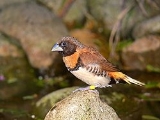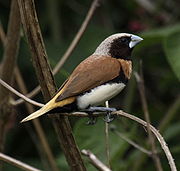
Chestnut-breasted Munia
Encyclopedia
The Chestnut-breasted Munia (Lonchura castaneothorax), also known as the Chestnut-breasted Mannikin or Bully Bird (in Australia), is a small brown-backed munia with a black face and greyish crown and nape. It has a broad ferruginous breast bar above a white belly. The species is found in Australia
, New Caledonia
, Indonesia
, and Papua New Guinea
. This species is also introduced to French Polynesia
& France
.
 The Chestnut-breasted Munia has a total of six subspecies and seven forms. The subspecies are as followed:
The Chestnut-breasted Munia has a total of six subspecies and seven forms. The subspecies are as followed:
L. castaneothora occurs in Tahiti
. Apparently, it is descended from L. c. castaneothorax. They are distinguished today by having paler underparts and by the scalloping of the nape extended onto the mantle.
John Gould wrote of it (Cayley 1932):
In New Guinea, the Chestnut-breasted Munia is a bird of drier areas and does not usually seen in jungle roads and clearings where other munias such as Grey-headed Mannikin are found.
In French Polynesia, it is well established as an introduced species, and its habits have developed somewhaat differently, indicating the adaptability of the species. It is widespread on the bracken-covered hill slopes, in pastures and gardens (it is not a garden bird in Australia), on cultivated land and wasteland, in forest ecotones and coconut plantations (Lever 1989)
Chestnut-breasted Munia is a highly sociable species, flocking in large number outside the breeding season. Breeding birds will join groups or flocks when foraging.
It has a distinct liking for Barley seed and thus the local people give it a name, Barley Bird. (Cayley 1932) The species is also fond of paspalum grass Paspalum longifolium, bullrush millet Pennisetum typhoides and Sorghum species. It is also been recorded that it feeds on feral millet Pannicum maximum and wild sugar cane Saccharum robustum in Papua New Guinea. (Bapista 1990)
Australia
Australia , officially the Commonwealth of Australia, is a country in the Southern Hemisphere comprising the mainland of the Australian continent, the island of Tasmania, and numerous smaller islands in the Indian and Pacific Oceans. It is the world's sixth-largest country by total area...
, New Caledonia
New Caledonia
New Caledonia is a special collectivity of France located in the southwest Pacific Ocean, east of Australia and about from Metropolitan France. The archipelago, part of the Melanesia subregion, includes the main island of Grande Terre, the Loyalty Islands, the Belep archipelago, the Isle of...
, Indonesia
Indonesia
Indonesia , officially the Republic of Indonesia , is a country in Southeast Asia and Oceania. Indonesia is an archipelago comprising approximately 13,000 islands. It has 33 provinces with over 238 million people, and is the world's fourth most populous country. Indonesia is a republic, with an...
, and Papua New Guinea
Papua New Guinea
Papua New Guinea , officially the Independent State of Papua New Guinea, is a country in Oceania, occupying the eastern half of the island of New Guinea and numerous offshore islands...
. This species is also introduced to French Polynesia
French Polynesia
French Polynesia is an overseas country of the French Republic . It is made up of several groups of Polynesian islands, the most famous island being Tahiti in the Society Islands group, which is also the most populous island and the seat of the capital of the territory...
& France
France
The French Republic , The French Republic , The French Republic , (commonly known as France , is a unitary semi-presidential republic in Western Europe with several overseas territories and islands located on other continents and in the Indian, Pacific, and Atlantic oceans. Metropolitan France...
.
Subspecies and location

- L. c. castaneothorax (Nominate race) occurs in eastern Australia.
- L. c. assimilis occurs in northern Australia. Identification: Richer breast and cream ground color to belly and flanks.
- L. c. ramsayi occurs in southeastern Papua New Guinea. Identification: Distinctive black head with faint scalloping. Female is more noticeable than the male.
- L. c. boschmai occurs in Lake WisselPaniai LakesThe Paniai Lakes, originally known as the Wissel lakes, consist of the three large, freshwater lakes Paniai, Tigi, and Tage. They are located in the central highlands of West Papua province, Indonesia...
area in Irian Jaya. Identification: Brown scallops on the flanks and paler to straw on the upper tail-coverts. - L. c. sharpii occurs in HollandiaJayapuraJayapura City is the capital of Papua province, Indonesia, on the island of New Guinea. It is situated on Yos Sudarso Bay . Its approximate population in 2002 was 200,000....
, Irian Jaya and Papua New Guinea. Identification: Pale grey on the head, and dull upper tail-coverts. - L. c. uropygialis occurs in Geelvink Bay in western Irian Jaya. Identification: Grey on the head not so pale, and note orange on the long upper tail-coverts.
L. castaneothora occurs in Tahiti
Tahiti
Tahiti is the largest island in the Windward group of French Polynesia, located in the archipelago of the Society Islands in the southern Pacific Ocean. It is the economic, cultural and political centre of French Polynesia. The island was formed from volcanic activity and is high and mountainous...
. Apparently, it is descended from L. c. castaneothorax. They are distinguished today by having paler underparts and by the scalloping of the nape extended onto the mantle.
Habitat
In Australia, the Chestnut-breasted Munia is known as a bird of reed beds and rank grasses bordering rivers, in swamp, in grassy country, and mangroves. It is commonly found in cane fields and cereal crops. In dry seasons, it is seen in arid country but always near water. It is also found in grassy woodland. (Slater et al. 1986)John Gould wrote of it (Cayley 1932):
In New Guinea, the Chestnut-breasted Munia is a bird of drier areas and does not usually seen in jungle roads and clearings where other munias such as Grey-headed Mannikin are found.
In French Polynesia, it is well established as an introduced species, and its habits have developed somewhaat differently, indicating the adaptability of the species. It is widespread on the bracken-covered hill slopes, in pastures and gardens (it is not a garden bird in Australia), on cultivated land and wasteland, in forest ecotones and coconut plantations (Lever 1989)
Habits and food
In Australia, during the breeding season Chestnut-breasted Muniais mostly seen in pairs, but in late autumn and winter months it congregates in large flocks, at times eating seeds of cereal crops.Chestnut-breasted Munia is a highly sociable species, flocking in large number outside the breeding season. Breeding birds will join groups or flocks when foraging.
It has a distinct liking for Barley seed and thus the local people give it a name, Barley Bird. (Cayley 1932) The species is also fond of paspalum grass Paspalum longifolium, bullrush millet Pennisetum typhoides and Sorghum species. It is also been recorded that it feeds on feral millet Pannicum maximum and wild sugar cane Saccharum robustum in Papua New Guinea. (Bapista 1990)

